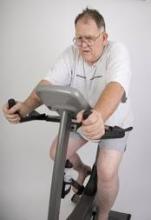Exercise may be at least as effective as many drug interventions with respect to mortality outcomes for secondary prevention of coronary heart disease.
A "meta-epidemiological" study of 12 drug-related meta-analyses, 4 exercise-related meta-analyses, and 3 recent exercise trials, – including over 339,000 subjects from 305 trials – demonstrated no statistically detectable difference in mortality between exercise and drug interventions for the secondary prevention of coronary heart disease and primary prevention of diabetes and demonstrated a slight increase in the efficacy of physical activity over drug treatment for patients with stroke, judging from findings of a Cochrane review.
In coronary heart disease the risk of dying were reduced with the use of statins (odds ratio, 0.82), beta-blockers (OR, 0.85), angiotensin converting enzyme inhibitors (OR, 0.83), and antiplatelets (OR, 0.83), compared with control, and the credible intervals for these drugs ranged from 0.72 to 0.96. Exercise interventions, however, had similar point estimates but wider credible intervals that extended on both sides of 1.00 (OR, 0.89; 95% confidence interval, 0.76-1.04), Huseyin Naci, a doctoral candidate and research fellow at the London School of Economic and Political Science, and Dr. John P.A. Ioannidis, professor of medicine and director of the prevention research center at Stanford (Calif.) University, reported online Oct. 1 in BMJ.
"When compared head to head in network meta-analyses, all interventions were not different beyond chance: there were no statistically detectable differences among any of the exercise and drug intervention in terms of the effects on mortality outcomes," the investigators said (BMJ 2013 Oct. 1 [doi: 10.1136/bmj.f5577]).
Additionally, with respect to stroke, exercise was significantly more effective than drug interventions were for reducing the risk of dying (odds ratios for exercise vs. anticoagulants, 0.09; and for exercise vs. antiplatelets, 0.10). However, there was considerable uncertainty in these findings, owing to a small number of events in the exercise trials, the investigators noted.
For heart failure, on the other hand, fewer deaths occurred with diuretics and beta-blockers, compared with control (OR, 0.19 and 0.71, respectively), and diuretics were more effective than exercise, angiotensin converting enzyme inhibitors, beta-blockers, and angiotensin receptor blockers (OR, 0.24, 0.21, 0.27, 0.21, respectively). For prediabetes, neither exercise nor drug interventions were clearly effective for reducing mortality.
"In secondary analyses comparing exercise with the drug interventions pooled together, there was no definitive difference between drug and exercise intervention in coronary heart disease, heart failure, and prediabetes, but effect sizes had modestly substantial uncertainty for heart failure and prediabetes," the investigators noted
The study "highlights the near absence of evidence on the comparative effectiveness of exercise and drug interventions on mortality outcomes. Existing evidence on the mortality benefits of physical activity is limited to the secondary prevention of coronary heart disease, rehabilitation after stroke, treatment of heart failure, and prevention of diabetes," they said, adding that the amount of evidence on the mortality benefit of exercise is dwarfed by that of drug interventions, and there is a clear lack of exercise and drug comparisons.
"Albeit this considerable asymmetry in the evidence base, our analysis suggests that exercise potentially had similar effectiveness to drug interventions with two exceptions," they said, noting that exercise appeared more effective for stroke rehabilitation and that diuretics outperformed all comparators for heart failure.
But when the drug interventions were considered together in sensitivity analyses, exercise and drug interventions did not differ in terms of mortality benefit "in all conditions except for stroke rehabilitation, where exercise interventions were associated with a reduction in the odds of mortality more than drug interventions," they said.
The findings highlight a "blind spot" in available scientific evidence resulting from an apparent bias against testing exercise interventions – an observation that highlights "the changing landscape of medical research, which seems to increasingly favor drug interventions over strategies to modify lifestyle," they added, noting that this "lopsided nature of modern medical research" may prohibit detection of the most effective interventions for a given condition if that intervention does not involve a prescription drug.
Nevertheless, the current findings suggest that exercise interventions should be considered as a viable alternative to – or alongside – drug therapy, they said, adding that a more nuanced consideration of the effectiveness of different types of physical activity is warranted.
The findings also point to a need for additional randomized trials on the comparative effectiveness of exercise and drug interventions. Given the scarcity of financial resources to fund such trials, the investigators proposed requiring that pharmaceutical sponsors of new drugs include exercise intervention as an active comparator arm in drug trials.


